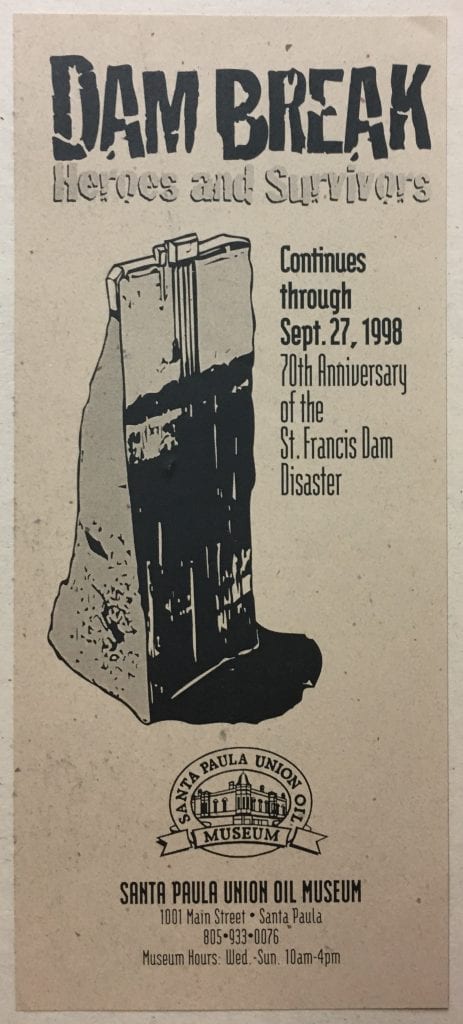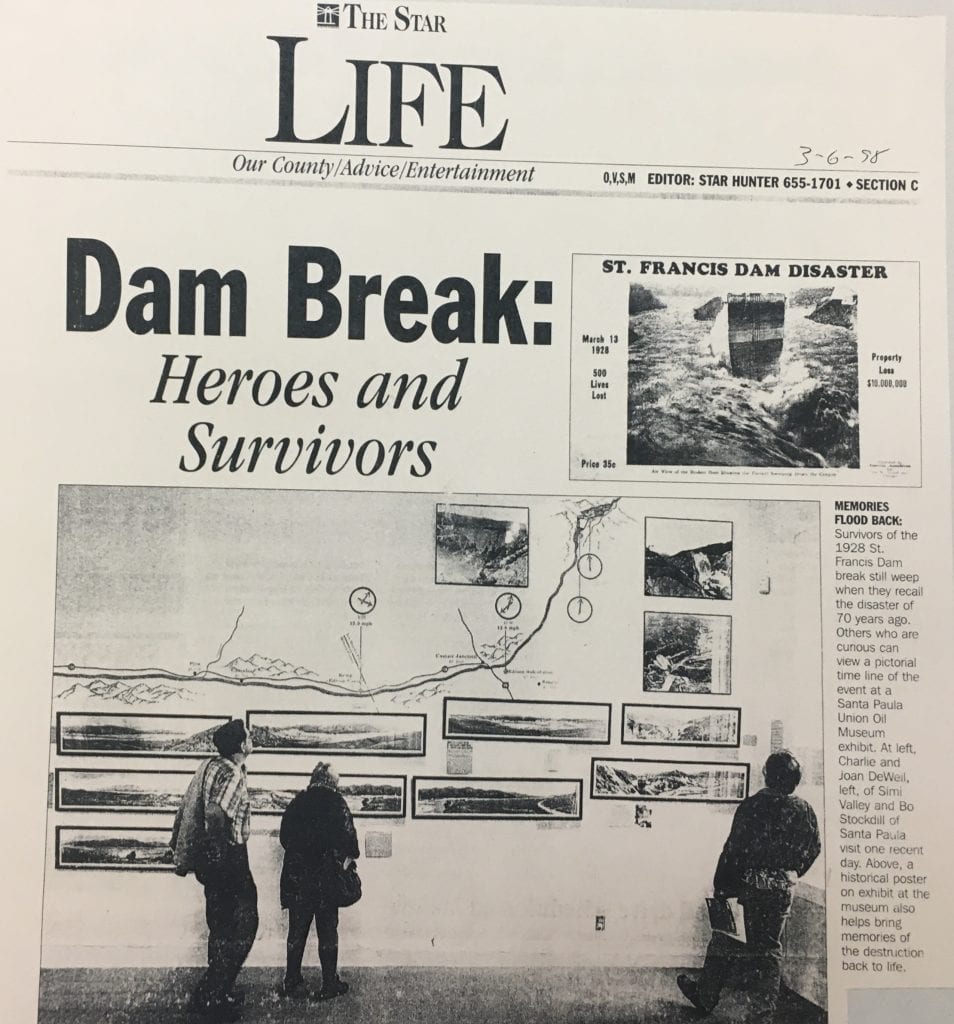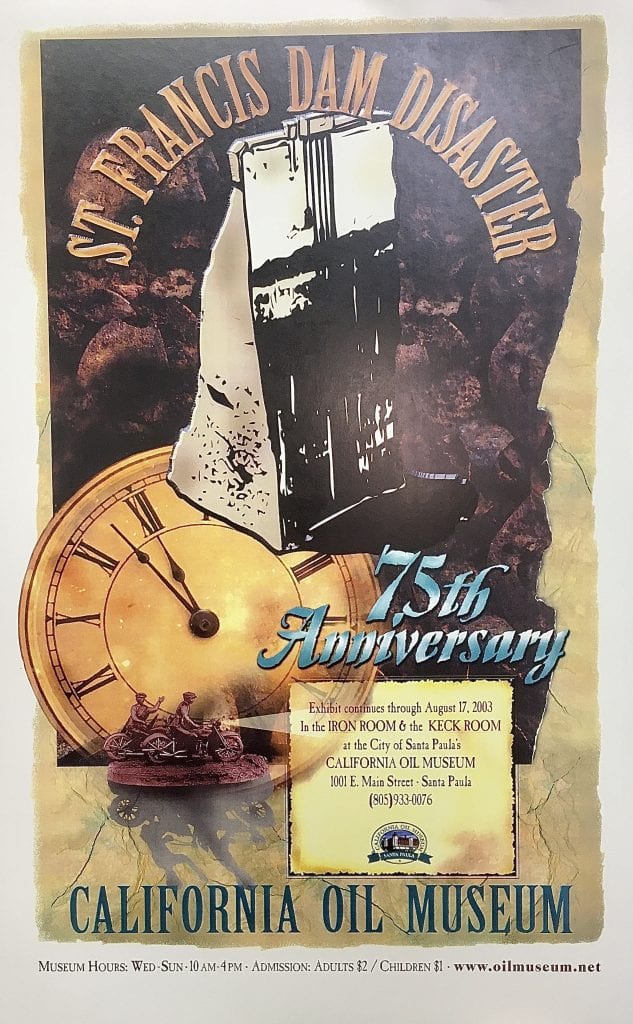By John Nichols

In 1984 I opened the John Nichols Gallery on weekends after 9 years teaching 7th-grade science and elementary school. During the week, I repaired window screens and screen doors out of my garage. The gallery specialized in vintage and contemporary photographs and fine art. Noon to 5, Fri. and Sat., no phone, no internet.

Early on, an older local woman visited and said to me, “Oh, you like old photographs. You should have this.” She handed me a small snapshot of a street in Santa Paula showing the St. Francis Dam disaster’s aftermath. I like viewing old photos, but despite growing up in Ventura and majoring in history at Northridge, I was totally unaware of that disaster. It took a few years, but that one small snapshot changed my life.
In 1986 I decided to go full time with the galley but needed a source of income to support the gallery, so I opened a book store and called it Mr. Nichols with the John Nichols Gallery in the rear. One day in 1988, I was sitting at the lunch counter of a downtown restaurant and the man sitting next to me said, “Say, you’re the guy who runs that book store, aren’t you? You should carry my books. I’m Charles Outland.” He died a few months later, so I could only ever deal in his used books.
The John Nichols Gallery part of the business presented several exhibits a year, and I continued to learn all the skills needed to organize and promote those exhibits. In 1990 the 1890 Union Oil Company Building in downtown Santa Paula was seismically retrofitted and turned into the Santa Paula Union Oil Museum (now the California Oil Museum). It was given to the City of Santa Paula for $1.00 a year rent. The city now had to run it. They called on me for advice, and I became their independent curator of exhibits for the next 10 years. As a third business, I started consulting on art, and history exhibits around the county under the name of Sespe Group – Creative Services.

Mike Nelson became the museum director and suggested that we create an exhibit on the St. Francis Dam Disaster. 1998 was the 70th anniversary, and we created “Heroes and Survivors, the 70th Anniversary of the St. Francis Dam Disaster.” I received a great piece of advice from Mike Nelson about creating this exhibit. He said, “Tell the human story.” We talk about engineering and geology a lot in any exhibit, but the human story is the most important topic to cover. The museum also discovered that disaster sells. The attendance was huge and much more than any other exhibit we ever had.
https://www.latimes.com/archives/la-xpm-1998-feb-05-ca-15849-story.html

In preparing for that and future exhibits, I started seriously collecting photographs, documents, and memorabilia of the St. Francis Dam disaster. Many survivors were still alive to help me with loans and gifts of material and first-hand stories. Since Santa Paula was ground zero for a lot of the flood’s impact, the number of old photos and documents, and stories available locally was relatively large.
In 2003 it was a natural to honor the 75th Anniversary with another exhibit.

By 2000 I had acquired a lot of historical perspective and hundreds of photographs, and several file cabinet drawers of documents and written recollections by survivors. Besides the original photos in my collection, I also accumulated as many digital scans of the flood images as I could. My SFD collection was just one of several different areas of interest I had in vintage photographs. Dealing in vintage photographs is a sort of specialized area, and the inventory of the John Nichols Gallery grew and grew in all areas. I used the internet a lot and listed myself as a Photo Historian on one website. A book publisher representative contacted me and asked me if I had over 200 photographs on any single topic. I had several collections that size, and it took me a couple of days to realize that my SFD collection of photos and data would be just right for this publisher.
That publisher was Arcadia Publishing, and they have a system where the author selects a series of photos with one or two to a page and captions of about 120 words depending on space available. This publisher used a template for their series of local history books, and I went to work. I became the first author in Ventura County to write for them. Now there are many local history books in that series.
In addition to the John Nichols Gallery in Santa Paula, I also partnered with Jennifer Heighton of the Live Oak Gallery of Santa Paula to share a satellite space for our galleries on 40 N. Fir St. in downtown Ventura. We were open on Saturday and Sunday, and I worked Sundays. The business was slow at first, so I had a lot of time to work on the book. I eventually finished it, and it was published in 2002. It is still in print and keeps selling.
I also have a Kindle-only book titled “Essay Man,” which contains my collected essays written over the last 30 years for newspapers and magazines.
2003 was the unveiling of “The Warning” monument in Santa Paula. This public art sculpture is on the corner of 10th and Santa Barbara St. near the Santa Paula Train Depot. This is the text on the plaque.
Saint Francis Dam Disaster Memorial Plaque
“The Warning”
Forged Steel by Eric J. Richards
Minutes before midnight on the chilly evening of March 12, 1928, the St. Francis Dam failed. The dam’s 200-foot high concrete wall crumpled and collapsed, sending billions of gallons of raging floodwaters down San Francisquito Canyon, about five miles northeast of what is now the city of Santa Clarita. The avalanche of water swept 54 miles down the Santa Clara River to the sea. No one knows the exact death toll, but more than 450 people perished in the disaster.
Shortly before 1:30 a.m. on March 13, an urgent message of the imminent disaster reached the night telephone operator in Santa Paula and was quickly relayed to police officers, city officials, and then homes in the lower portions of town. Among the many heroes of the flood, that evening were two motorcycle officers who rode through the night to warn the sleeping citizens in the low lying areas of Santa Paula that a torrent of water was about to inundate their homes. Their wild ride that night was stopped at 3:05 a.m. when the wall of water swept through Santa Paula on its way to the ocean.
Many stories of heroism and courage emerged in the aftermath of the flood. This monument represents one such act of heroism.
Dedicated March 2003
“I was an “Artistic Advisor” on that project and was familiar with public art through work with the Arts and Business Council of Santa Paula and the creation of the 9 murals in the downtown.
In discussions with the public during the development of this monument, we addressed honoring individual police officers on the monument by name. We all knew that the two motorcycle riders who rode around the city on the night of the flood and warned the citizens were Thornton Edwards and Stanley Baker. In that discussion, we shifted away from a monument to two individuals who performed heroic acts to creating a monument to honor the spirit of heroism. We decided to honor the spirit of heroism that we felt could exist in every person of every age faced with a disaster and called to act courageously.
For that reason, the names of individuals were left off of the monument so that the focus could be directed to the many heroic acts during and after the disaster struck performed by countless citizens.”
“The Spirit of Heroism”
An oration delivered by John Nichols at the unveiling of Eric J. Richards’ monumental sculpture “The Warning” on March 16, 2003, at Railroad Plaza. The Rotary Club of Santa Paula made a major contribution to the project. Many survivors of the St. Francis Dam Disaster were in the audience with their friends and families.
Many people here are alive today because of heroic acts performed before dawn on March 13, 1928, and in the days after. Many here today survived and went on to have children and grandchildren. Entire family lines could have been snuffed out that night without the acts of heroism that we honor here today.
For the past few years, many of us here in Santa Paula have been thinking over the concept of heroism. In 1998 for the 70th anniversary of the St. Francis Dam Disaster, Mike Nelson came up with the title for our exhibit at the City of Santa Paula’s California Oil Museum. It was “Heroes and Survivors.” That title guided the direction of the exhibit. We chose to honor the memory of the victims by telling the stories of the living. As the idea for the subject of the monumental sculpture took shape, we followed that same path.
What has emerged out of the history of the death and destruction caused by the flood are many true stories of heroic acts performed by ordinary citizens. The stories are coming forth in books and newspaper articles, in museum exhibits and video documentaries, in radio and television interviews, and in monuments like the one we are unveiling today.
The stories swirl around, and it is impossible to put them in any order of importance. There was a night telephone operator named Louise Gipe who was working the switchboard when she got a warning of impending disaster. She knew that the wall of water was as high as a 10-story building when it left the dam. She had no way of knowing that she would not be buried in the flood when it came through Santa Paula. She only knew that her neighbors must be warned. Other “Hello Girls” stayed at their post in Saticoy.
Louise called motorcycle officer Thornton Edwards who jumped on his Indian-4 and rode to the lowland territories. That was the area that the floodwaters would soon be sweeping over. Many others joined in the efforts to warn their fellow citizens that night. Stanley Baker was riding his Harley Davidson through the streets at most risk. Thornton Edwards made the time-saving and life-saving decision to go to every third house and told the occupants to warn their immediate neighbors. Then he went to the fifth house and repeated the process until the block was covered.
Others who spread the warning at the risk of their lives were Eddie Hearne, Lee Sheppard, John Messer, and Sam Primmer. Private citizens were also risking their lives to help save their neighbors and spread the warning.
Dealing with the aftermath of the flood took heroic efforts on the part of the community. The dead had to be found and properly buried. The survivors had to be rescued and fed and clothed, and housed. Homes and businesses and ranches and schools had to be slowly rebuilt.
Because there was such a great outpouring of acts of heroism that night, no single monument could contain a representation of each act. One act was chosen to represent all acts of heroism. “The Warning” represents one act of heroism to symbolically represent all acts of heroism. That is one of the reasons that the names of the heroes have been intentionally left off of the monument.
When I think about a monument to the Spirit of Heroism, I feel sad for the death and destruction that the flood caused. I also feel uplifted by the knowledge that within human beings, there is a spirit of heroism dimly flickering, just waiting for a situation to ignite it. When a situation presents itself, the spirit of heroism bursts into flame, and lives are saved.
When all is done, the hero goes back to being a normal, average human being. I’ve never been called upon to perform a heroic act. I don’t know what I will do if a situation ever presents itself. I don’t think I’ll have any control over my actions. I could run away from the danger, or I could become a hero. I’ll be thinking about that for the rest of my life as I drive by the sculpture.
As a piece of public art, “The Warning” will join the series of murals that have been painted around Santa Paula. Collectively they show the world that the priorities of Santa Paula are our history and heritage and our respect for the past. We also respect the people who tell us the stories of our past. We respect age. This gathering today is about art and sculpture and motorcycles and floods and trains, but it is also about listening to the stories that age can tell us.
While the rest of the world seems to worship youth and all things new and shiny, Santa Paula can show that there are more enduring values. Values like respect for age and honoring the past.
Values like heroism and survival and rebuilding and renewing.
“In 2008, it was a natural to create ‘St. Francis Dam Disaster: 80th Anniversary Exhibit’. Co-curated by Jennifer Heighton, who is now Executive Director of the Santa Paula Art Museum.
After years of collecting and accumulating, I had about 3 or 4 file cabinet drawers full along with prints of most of the very rare panorama photographs taken just after the flood. Those were all acquired by the Museum of Ventura County, where they now reside next to the Charles Outland archive. Santa Clarita Valley Historical Society acquired duplicates and many other photos. I kept digital copies of everything and continue to accumulate a digital archive. “
In 2018 it was the 90th Anniversary, and one of the events to commemorate that event was a candlelight memorial in the historic Ebell Park in Santa Paula. It was organized by Edward Arguelles, a retired history teacher who serves on the Santa Paula Historical Society board. John Nichols was one of the speakers and presented his essay, “The Spirit of Heroism.”
Estimated reading time: 12 minutes
